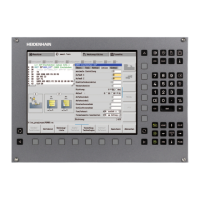778 HEIDENHAIN Technical Manual MANUALplus 620
In MP_mode, define the type of coupling. Select the Torque entry for the
torque coupling.
At present, only a static coupling is possible for the torque coupling.
Therefore, in MP_type, enter the value Static.
Therefore, in MP_posEncoderInput, enter the value None for the slave.
Axes for which master-slave torque control is active cannot be switched by
the PLC to single-axis operation during operation.
Setting the master-
slave torque control
for minimizing
mechanical play
For the master and slave axes you must select in MP_inverseVelocity the
same or the opposite direction of rotation, depending on the application
(MP_signCorrActualVal has no effect on the slave).
Adjust the current controller for the master and slave axes.see
"Commissioning" on page 1072
Not on the CC 61xx:
Enter the following temporary values in the machine parameters for the
slave axis:
MP_torqueBias = approx. 20% to 25% of the rated torque of the motor
MP_propGain = 3
MP_speedCorrectRatio: = 0
Not on the CC 61xx:
In MP_torqueDistrFactor, enter the ratio of the mass moment of inertia of
the master to the mass moment of inertia of the slave. For identical motors,
therefore, the value to be entered is 1.
If you use a position encoder, in MP_speedCorrectRatio enter 100 for the
slave axis; if you do not use a position encoder, enter the value 0 in
MP_speedCorrectRatio (not on the CC 61xx).
Enter MP_vCtrlIntGain (I factor of speed controller) = 50 or, if you have one,
an empirical value for your motor.
Adjust the P and I factor of the speed controller for the master and slave
axes at the same time. See see "Commissioning" on page 1072. It is not
permissible to commission the master and slave axes separately, since the
motors must be tensioned during commissioning.
If you do not reach the desired rise time (approx. 10 ms), you can increase
the P factor with the aid of a filter. Here the band-rejection filter is preferable
to the low-pass filter.
To find the center frequency for the band-rejection filter, slowly increase the
P factor to the oscillation limit and find the frequency with the integrated
oscilloscope.
For low-frequency oscillations (< approx. 200 Hz) you should not use a filter,
because it may have a negative influence on the dynamics of the control.
For the mid-range frequency (approx. 200 Hz to approx. 400 Hz) ensure that
you do not excite any low-frequency oscillation.
The higher the frequency of the oscillation (> approx. 400 Hz), the less
negative will be the influence of high damping on the dynamics.

